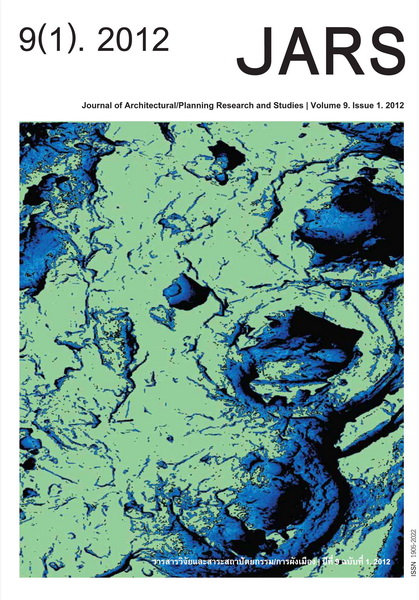Understanding Urban Community amid Capitalism: A Case Study of the Crown Property Bureau’s Superblock
Main Article Content
Abstract
บ่อยครั้งที่การพัฒนาเมืองโดยการลงทุนบนที่ดินได้นำมาสู่การเปลี่ยนแปลงทางกายภาพของเมืองและสภาพแวดล้อม
ภายใต้วัฏจักรนี้ชุมชนเมืองมักเป็นหนึ่งในพื้นที่ซึ่งได้รับผลกระทบจากการพัฒนา อย่างไรก็ตาม การศึกษาเพื่อทำความเข้าใจ
ชุมชนเมือง โดยเฉพาะชุมชนที่อยู่ในย่านใจกลางเมือง (Central Business District) นั้น มักถูกมองข้ามบ่อยครั้งเมื่อการ
ลงทุนเพื่อการพัฒนาที่ดินมักถูกให้น้ำหนักมากกว่า บทความนี้ต้องการสร้างความเข้าใจเกี่ยวกับชุมชนเมืองโดยศึกษาใน
กรณีศึกษาชุมชนบนที่ดินของสำนักงานทรัพย์สินส่วนพระมหากษัตริย์ 6 ชุมชน โดยวัตถุประสงค์เพื่อต้องการสะท้อนภาพ
ชุมชนเมืองที่มีความสัมพันธ์ภายในชุมชนที่หลากหลาย ภายใต้คุณสมบัติ 3 ลักษณะ ได้แก่ 1) ลักษณะทางกายภาพ
2) ลักษณะทางสังคม-เศรษฐกิจของครัวเรือน และ 3) ความคาดหวังต่อการพัฒนา โดยผลลัพธ์จากการศึกษาพบคุณลักษณะ
ที่สำคัญ คือ เมืองประกอบด้วยโครงสร้างทางสังคมเหลื่อมทับกันอยู่ 2 ลักษณะ ได้แก่ 1) ความสัมพันธ์ทางสังคมแบบชุมชน
ดั้งเดิมและชุมชนที่มีการปรับปรุง และ 2) ปัจจัยที่ส่งผลต่อความต้องการในการปรับปรุงทางกายภาพของชุมชนและที่อยู่
อาศัย ผลการศึกษา พบว่า ความสัมพันธ์ระหว่างเงื่อนไขทางกายภาพและประโยชน์ทางเศรษฐกิจที่ผูกติดกันอย่างแนบแน่น
ในปัจจุบัน ทำให้การพัฒนาเปลี่ยนแปลงลักษณะทางกายภาพของชุมชนทำได้ยาก ในท้ายสุดงานวิจัยได้สะท้อนให้เห็นว่า
ความไม่เป็นเอกภาพและความสลับซับซ้อนในชุมชน และอาจส่งผลต่อความไม่ชอบธรรมของชุมชนในการยืนหยัดอาศัยใน
พื้นที่ โดยชุมชนจำต้องเร่งสร้างพื้นที่เจรจาต่อรองกับเจ้าของที่ดินโดยเร็วเพื่อประโยชน์ร่วมกัน
Downloads
Article Details

This work is licensed under a Creative Commons Attribution-NonCommercial-NoDerivatives 4.0 International License.
All material is licensed under the terms of the Creative Commons Attribution 4.0 International (CC-BY-NC-ND 4.0) License, unless otherwise stated. As such, authors are free to share, copy, and redistribute the material in any medium or format. The authors must give appropriate credit, provide a link to the license, and indicate if changes were made. The authors may do so in any reasonable manner, but not in any way that suggests the licensor endorses you or your use. The authors may not use the material for commercial purposes. If the authors remix, transform, or build upon the material, they may not distribute the modified material, unless permission is obtained from JARS. Final, accepted versions of the paper may be posted on third party repositories, provided appropriate acknowledgement to the original source is clearly noted.
References
Baker, C. (2000). Thailand’s assembly of the poor: background, drama, reaction. South East Asia Research, 8(1), 5-29.
Barnes, S. L. (2004). Positive homeownership attitudes, homeownership behavior, and neighborhood ties in poor urban neighborhoods. Cityscape, 7(1), 41-55.
BMA reconsiders ‘Asok-Sarasin’, Elevated highway ‘Sukhumvit-Rama IX’ [กทม.ปัดฝุ่นโปรเจ็กต์ “อโศก-สารสิน” ผุดทางยกระดับ ‘สุขุมวิท-พระราม 9’ ตึกสูงกลางกรุงระทึกจ่อถูกเวนคืน]. (2010). Krungthepdhurakij, Retrieved May 11, 2011 from http://www.prachachat.net/news_detail.php?newsid=1278064242&grpid=02&catid=no.
Boonpanya, B. (2006). สามทศวรรษแนวคิดวัฒนธรรมชุมชน [Three decades of cultural community concepts]. Bangkok: Dok Pah Tiew Publishing Projects.
Boonyabancha, S., & Kerr, T. (2003). Making development budgets work better: Housing loans and poverty reduction in Thailand. Small Enterprise Development, 14(1), 42-48.
Daniere, G., & Takahashi, L. M. (1999). Poverty and access: Differences and commonalties across slum communities in Bangkok. Habitat International, 23, 271-288.
Delanty, G. (2003). Community. London: Routledge.
Forrest, R., & Kearns, A. (2001). Social cohesion, social capital, and the neighborhood. Urban Studies, 38(12), 2125-2143.
Fraser, J. C., Lepofsky, J., Kick, E. L., & Williams, J. P. (2003). The construction of the local and the limits of contemporary community building in the United States. Urban Affairs Review, 38(3), 417-445.
Giddens, A. (1984). The constitution of society: Outline of the theory of structuration. Berkeley: University of California Press.
Giles, C. (2003). The autonomy of Thai’s housing policy, 1945-1996. Habitat International, 27, 227-244.
Harvey, D. (1990). The Condition of Postmodernity: An Inquiry into the Origins of Cultural Change. Oxford: Blackwell.
Hagreves, A. (2004). Building community of place: Habitual movement around significant places. Journal of Housing and the Built Environment, 19, 49-65.
Jameson, F. (1991). Postmodernism, or the Cultural Logic of Late Capitalism. Durham: Duke University Press.
Kallus, R., & Law-Yone, H. (2000) What is a neighbourhood?: The structure and function of an idea. Environment and Planning, B 27, 815-26.
Kearns, A., & Parkinson, M. (2001). The significant of neighborhood. Urban Studies, 38(12), 2103-2110.
Lyons, M., & Snoxell, S. (2005). Creating urban social capital: Some evidences from informal traders in Nairobi. Urban Studies, 42(7), 1077-1097.
Nartsupa, C. (2010). การเป็นสมัยใหม่กับแนวคิดชุมชน [Modernization and community concepts]. Bangkok, Thailand: Sangsan Books.
Ouyyanont, P. (2008). The Crown Property Bureau in Thailand and the crisis of 1997. Journal of Contemporary Asia, 38(1), 166-189.
Polsri, S. (2002). ทฤษฎีและหลักการพัฒนาชุมชน [Theories and principles for community development] (4 ed.). Bangkok: Odien Store.
Sharkawy, M. A., & Chotipanich, S. (1998). Housing segmentation in developing countries in transition: A recent case study of residential development in Bangkok. Journal of Real Estate Literature, 6(1), 29-42.
Sheng, Y. K. (2002). Housing, the state and the market in Thailand: Enabling and enriching the private sector. Journal of Housing and the Built Environment, 17(1), 33-47
Sintusingha, S. (2006). Sustainability and urban sprawl: Alternative scenarios for a Bangkok Superblock. Urban Design International, 11, 151-172.
The Consortium for Action Planning. (2010). The Study of Living Conditions and Residential Development Guidelines on the Superblock, Rama IV Road, Study report submitted to the Crown Property Bureau, March. Bangkok: Author.
The Crown Property Bureau. (2008). นโยบายการบริหารสำนักงานสำนักงานทรัพย์สินส่วนพระมหากษัตริย์ [The Crown Property Bureau’s Policy]. Retrieved June 3, 2011, from http://www.crownproperty.or.th/th/vision/policy.html
Walaisathien, P. (2000). ชุมชนและลักษณะความเป็นชุมชน [Community and the Community Characteristics]. In the 1st Annual Meetings on Community, Thai community amidst changes (pp. 1-14). Bangkok: Thailand Research Fund.
Walaisathien, P., et al. (2000). กระบวนการและเทคนิคการทำงานของนักพัฒนา [Development practitioners’ tools and techniques]. Bangkok, Thailand: Thailand research Fund.
Webber, R. (2007). The metropolitan habitus: Its manifestation, locations, and consumption profiles. Environment and Planning A, 39, 182-207.
Yap, K. S., & De Wandeler, K. (2010). Self-help housing in Bangkok. Habitat International, 34(3), 332-341.


